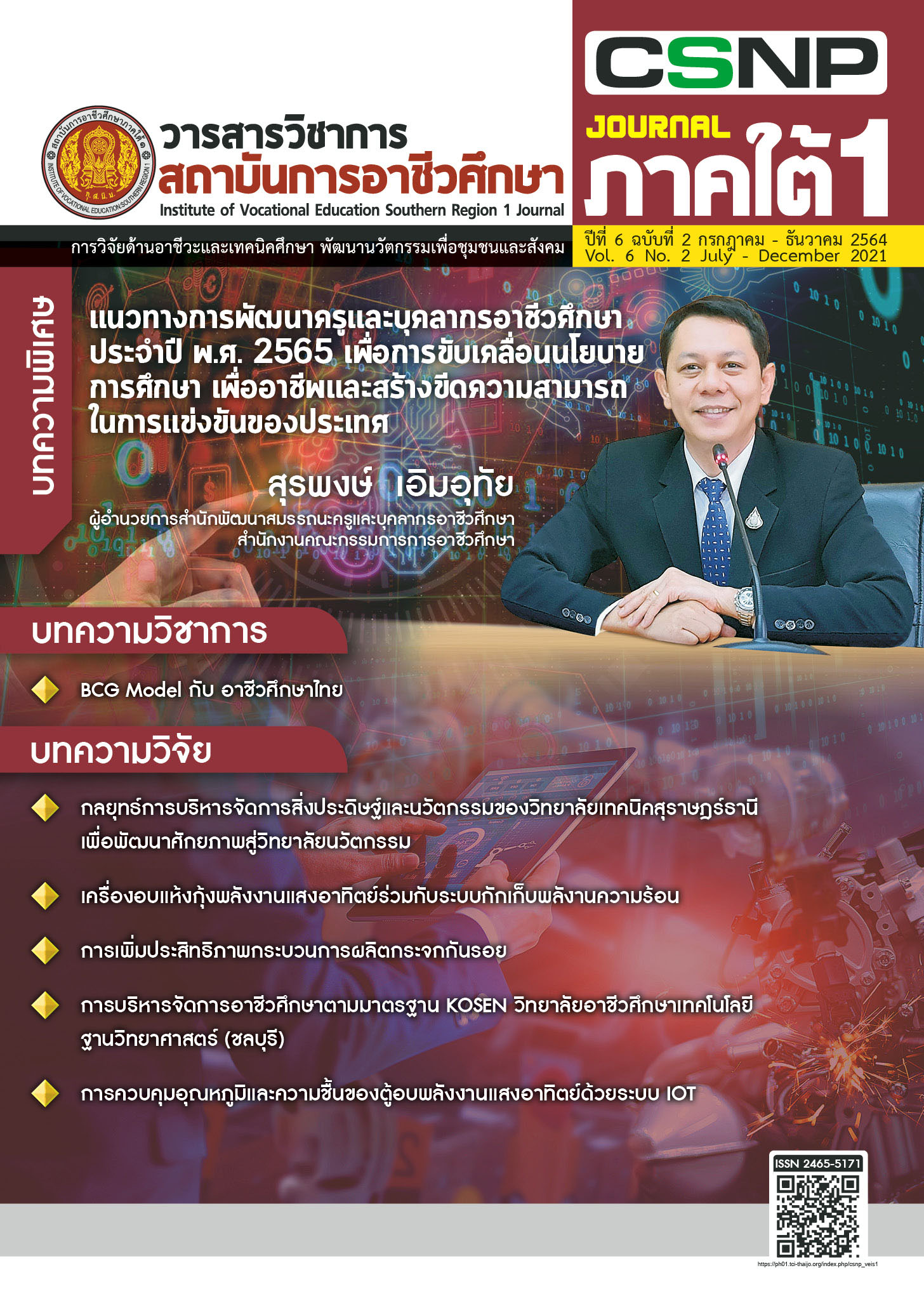Efficiency Improvement in Automotive Parts Manufacturing Process by Work Improvement Techniques
Keywords:
ECRS Principle, Work Instruction, Production Efficiency ImprovementAbstract
The objectives of this project were to: 1) study the working process, 2) explore the problems and wastes, and 3) set a standard for working in the process of convex pressing in the pump production line. The case study factory in this research was an automobile parts factory in Nonthaburi Province. Initially, the production process was studied to find out which process failed to produce as planned. The problem was then analyzed by brainstorming with why- why analysis. It was found that the pre-production process of convex pressing took too much time resulting in inefficiency in production as planned. Then, the procedure was improved by using the ECRS technique and the working process was standardized in a work instruction format.
After the improvement, the convex pressing pre-production process was reduced from 15 steps to 11 steps. The motion distance was shortened from 35 meters to 12 meters or 65.70 percent and the preparation time of 20 minutes was reduced to 7 minutes or 65 percent.
References
เอกชัย บุญจง. (2551). การปรับปรุงประสิทธิภาพการผลิตชิ้นส่วนยานยนต์โดยใช้เทคนิคการควบคุมคุณภาพและการปรับสมดุลการผลิต กรณีศึกษา : บริษัท เคียวคุโย อินดัสเตรียล (ประเทศไทย) จำกัด. สารนิพนธ์วิศวกรรมศาสตรมหาบัณฑิต สาขาวิชาวิศวกรรมการจัดการอุตสาหกรรม ภาควิชาวิศวกรรมอุตสาหการ บัณฑิตวิทยาลัย มหาวิทยาลัยเทคโนโลยีพระจอมเกล้าพระนครเหนือ, กรุงเทพมหานคร.
ดาริกา อวะภาค ศุภชัย ภิสัชเพ็ญ และ มณฑิรา เอียดเสน. (2554). การลดเวลาสูญเสียในกระบวนการผลิตไอศกรีมแท่ง. ใน เรื่องเต็มการประชุมทางวิชาการของมหาวิทยาลัยเกษตรศาสตร์ ครั้งที่ 49: สาขาสถาปัตยกรรมศาสตร์และวิศวกรรมศาสตร์ (น. 199-207). กรุงเทพมหานคร: สำนักงานกองทุนสนับสนุนการวิจัย.
เกียรติพงษ์ อุดมธนะธีระ. (2561). [ออนไลน์]. Lean ความสูญเสีย 8 ประการ (8 Wastes DOWNTIME). [สืบค้นเมื่อวันที่ 4 ตุลาคม 2563]. จาก https://www.iok2u.com/index.php/article/industry/243-8-8-wastes-downtime.
คณิต เฉลยจรรยา. (2543). ความสูญเสีย 7 ประการ (7 Waste). กรุงเทพมหานคร: สถาบันเพิ่มผลผลิตแห่งชาติ.
บิสซิเนส บูลเลทีน เซอร์วิส. (2559). [ออนไลน์]. เครื่องมือคุณภาพ 7 ชนิด (7 QC Tools). [สืบค้นเมื่อวันที่ 8 ธันวาคม 2563]. จาก http://econs.co.th/index.php/2016/07/29/7-qc-tools/.
รัชต์วรรณ กาญจนปัญญาคม. (2552). การศึกษางานอุตสาหกรรม. กรุงเทพมหานคร: ท้อป.
ธารชุดา พันธ์นิกุล ดวงพร สังฆะมณี และปรีดาภรณ์ งามสง่า. (2557). การปรับปรุงประสิทธิภาพในกระบวนการผลิตด้วยเครื่องมือทางวิศวกรรมอุตสาหการ กรณีศึกษา: โรงงานประกอบรถจักรยาน. การประชุมวิชาการข่ายงานวิศวกรรมอุตสาหการ ประจำปี พ.ศ. 2557 วันที่ 30-31 ตุลาคม 2557 น. 227-334, สมุทรปราการ.
ณัฐพงษ์ คงประเสริฐ. (2562).[ออนไลน์]. Why Why Analysis. [สืบค้นเมื่อวันที่ 4 ตุลาคม 2563]. จาก http://qd.swu.ac.th/Portals/2077/Why%20Why%20Anlysis.pdf?ver=2562-05-24-082545-380.
ณัฐนนท์ จิวะไพศาลพงศ์. (2555). การปรับปรุงประสิทธิภาพการดำเนินการด้านห่วงโซ่อุปทานของโรงงานผลิตบรรจุภัณฑ์พลาสติก. สารนิพนธ์วิศวกรรมศาสตรมหาบัณฑิต สาขาการจัดการทางวิศวกรรม มหาวิทยาลัยธุรกิจบัณฑิตย์, กรุงเทพมหานคร.
สรณ์ศิริ เรืองโลก. (2560). การปรับปรุงประสิทธิภาพของสายการผลิตสมอลล์เอิร์ทลีคเบรกเกอร์,การค้นคว้าอิสระวิศวกรรมศาสตรมหาบัณฑิต สาขาวิชาการพัฒนางานอุตสาหกรรม ภาควิชาวิศวกรรมอุตสาหการ มหาวิทยาลัยธรรมศาสตร์, กรุงเทพมหานคร.
Downloads
Published
Issue
Section
License
Copyright (c) 2021 Institute of Vocational Education Southern Region 1 Journal

This work is licensed under a Creative Commons Attribution-NonCommercial-NoDerivatives 4.0 International License.



